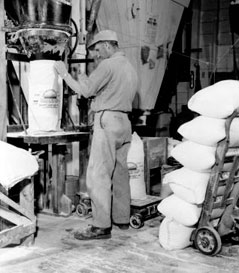|
IN
1894 HAMMOND AND LECKIE, with their lumber yard and grain elevator
returning them satisfactory profits, decided to enter the flour milling
business. They formed a company with the financial support of an
American grain merchant, W.N .Thomson of Jackson City, Michigan, who
invested several thousand dollars in the project.
By the autumn of 1893 the mill building, a substantial brick structure,
was completed. In February of the following year quality machinery was
installed and milling of the stored grain from the 1893 crop was begun.
Coal from Estevan and water, drawn by tanks from the river, provided
the steam power.
In 1896 the company secured the services of James Innes as miller and
Dexter Lewers as engineer. A pipeline to the river made the supply of
water more easily obtainable. The mill turned out excellent flour from
locally grown wheat and from grain shipped in by carload lots on the
CPR. Most of the flour was shipped to Eastern Canada. Some went
overseas to Britain and to France. A letter of praise for its fine
quality from M. Neveaux of Marseilles, France was but one of many
commendations received by James Innes for his product in 1900, the same
year that the Hartney mill was awarded one of the top prizes at the
Paris Exhibition. That year, operating day and night with a staff of
ten men, the mill turned out 200 barrels of flour daily, and shopped 14
carloads monthly, besides supplying the local trade.
In 1902 James Innes formed a partnership with Frank Hill, who had that
year retired from his Whitewater farm and, with his wife and three
daughters, taken up residence on Queen Street. Innes and Hill purchased
the shares of the mill shares formerly owned by Thomson of Jackson
City, as well as the elevator formerly owned by Hammond and
Leckie. Mr Inness operated the mill while
Mr. Hill engaged in buying and shipping livestock purchased from the
farmers.

This archival image shows a miller at work.
By 1906 there were many flour mills in Manitoba – to many for any of
them to make a satisfactory profit. James Innes felt that direct
marking arrangements with Britain might improve the situation and,
after discussion with several mill owners in the province, he went to
Montreal and succeeded in forming a marketing organization for 19 of
the Manitoba mills which became “The Canadian Consolidated Flour Mills.”
Suddenly disaster struck. A Chicago grain merchant cornered the grain
market in September 1907. The western grain firms, including The
Hartney Milling Company had bought grain for delivery and found
themselves short of funds to cover their purchase, The Union Bank,
alarmed by the situation, gave Innes a few hours to pay off his grain
loans. He had the grain in storage but could neither produce the
necessary funds nor sell the grain immediately. The bank seized the
mill. It was closed in September, while the Hartney board of trade
tried desperately and fruitlessly to find a solution that would help
Innes and set the mill wheels turning again. They formed a joint stock
company to buy the mill from the Union Bank. In a few days $6,000 was
raised by a provisional board. And by May 1908, $15,000 worth of stock
was sold and “The Hartney Flour Milling Company” was formed. Ultimately
no resolution was forthcoming - the bank refused the offer and even to
rent the building, which remained closed. The mill building sat idle
and the milling machinery was sold and moved eventually. The mill and
elevator beside it were torn down.
Pump
Manufacturer H.C. Pierce
At the time of the town’s beginning H.C. Pierce, knowing that every
farmer hoped to have a well on his farm, opened a pump factory in a
building opposite the Bateman house on the corner of West Railway and
William. In 1894 he turned out 1,000 pumps to replace the ropes, pails
and windlass arrangements that were used at first to draw water. When
most of the farmers were supplied with pumps, and demand for them began
to fall off, Mr. Pierce disposed of his building to Edward Hornibrook
who used it as an implement warehouse for a few years.
Adapted from: The Mere Living, page 166 and 104.
|





